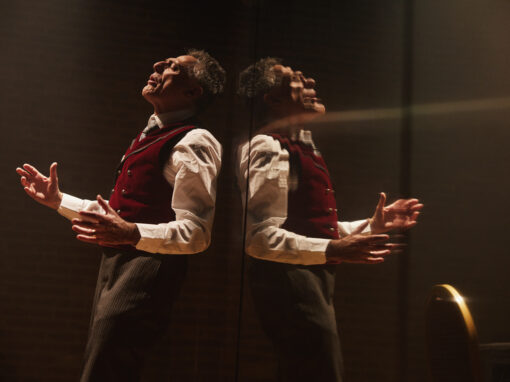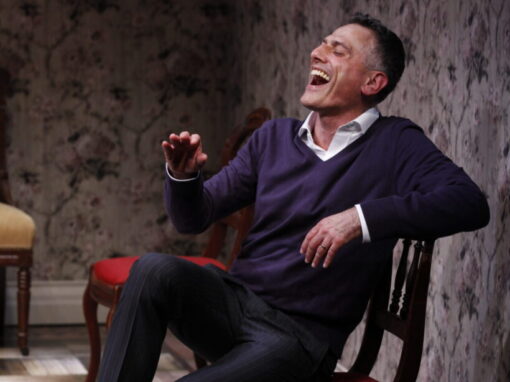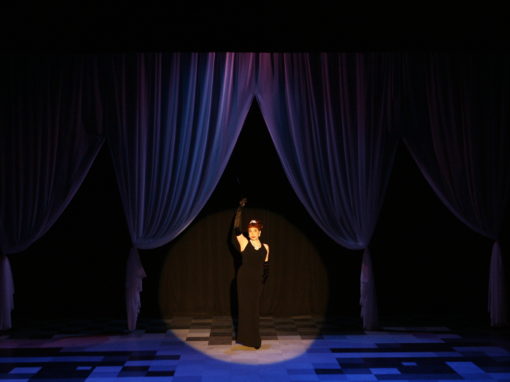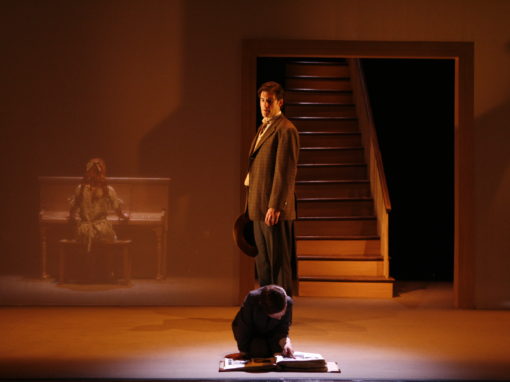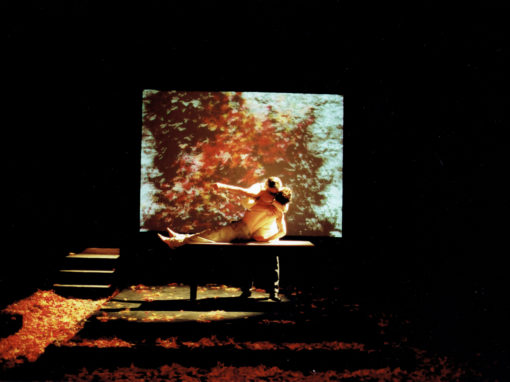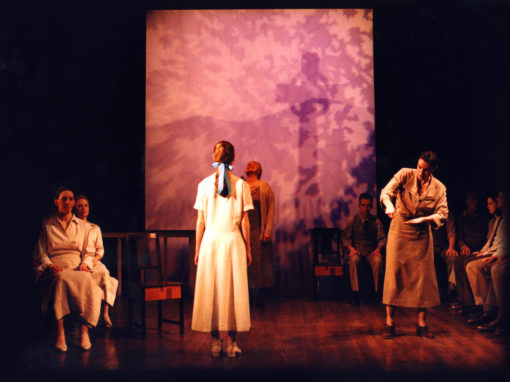Perpendicular Ideas // by Mia Katigbak
Actor Mia Katigbak recalls a complex collaboration from many angles.
I had only a nodding acquaintance with Jack Cummings III.
Wait, let me back up a bit. Transport Group and NAATCO, my company, have offices on the same floor and since Jack and I kept the same hours (late), I’d sometimes pass him in the hallway. He was usually on the phone; I was usually thinking about other things. We didn’t even nod. Then one day NAATCO and Transport Group had to attend the same fire drill meeting with management and we really still didn’t didn’t pay attention to each other because it was one of those “(eye roll) Do we really have to do this?” meetings. But Jack and I would now at least nod at each other in passing. Barely.
Then one day, Jack popped his head into my office and asked “Has your agent been in touch? We want to make an offer.” And then he disappeared. That was the shortest visit I have ever had from Jack.
The offer was to take over Barbara Barrie’s role in Transport Group’s 2014 production of I Remember Mama, which was being remounted by Two River Theater in Red Bank, NJ in the summer of 2016. I am Asian American, and hell yeah, I’ll do the titular “I” role of a 16-year-old Norwegian American in a play about her family and community of Norwegian immigrants in early 20th century San Francisco. I would be part of a cast of women whose youngest member was in her early 60s. In addition to breaking conformities of casting, gender and age-wise, the remount would have an Asian American and a Black actor, Marjorie Johnson. This kind of “transgressive” casting practice is right up my alley. NAATCO has been deeply invested in something similar for the past 30 years, persistently asserting that Asian Americans can capably, in fact excellently, portray characters outside the stereotypic confines that continue to prevail in the industry. To force the issue, two of our four programs present plays by White people about White people with all-Asian American casts. We don’t play White people; we just play people. I continue to be astounded that in the 21st century, the powers that be in a medium that supposedly trades in the currency of imagination cannot fathom that someone who looks like me could, in fact, be culturally Scandinavian. Or that people who look like Jack could be the biological sibling of a person who looks like me. It actually happens in real life.
After the run at Two River, Jack took to dropping by my office for longer and longer visits. Early on, I ranted about the above, and this was the beginning of Jack’s education on Asian Americans. I am not being facetious or facile or snide. What I appreciate about Jack is his ability to be the first to acknowledge gaps in his awareness. After our work together, Jack confronted himself about rarely casting Asian Americans. Having had his consciousness raised, he asked if he could keep consulting me.
And he did, fearlessly asking questions that no self-respecting liberal, enlightened artist would be caught dead asking for fear of being thought ignorant or bigoted. Jack charged in, frequently prefacing a session with, “OK, is this racist?” A lot of the time, the answer was “yes,” but—not without cost to his ego—he’d forge ahead with follow-up questions asking for elaboration. Glutton for punishment. But change is painful, and it does not happen overnight.
Fast forward a couple of years (during which the consultation continued), and Jack came to me with a proposal. He had an idea to stage Daniel Berrigan’s The Trial of the Catonsville Nine with three Asian American actors. He wanted me to be one of the actors and asked that NAATCO partner with Transport Group. I am old enough to remember that trial in 1968, during which nine Catholic activists, all White, led by Father Daniel Berrigan, burned draft files in protest of the Vietnam War. This was at first a conceptual challenge for me. The trial was about White people protesting a war in Asia, and all the characters (defendants, judge, attorneys) would be portrayed by Asian Americans. Something about the way Jack was framing it though (and in truth I wasn’t clear about it), was very intriguing.
My interpretation of Jack, from working with him and watching his shows, is that he operates via complex creative mathematical problems in his mind when he thinks up a project. The odd idea, the weird proposal, the extraordinary re-setting at the outset—these are actually very large, multi-factored equations that he will begin to solve during rehearsals. The end product gives the unique satisfaction of an elegant geometry proof.
I loved geometry in high school. I was very good at it and it was from my math teacher that I first heard that proofs could be elegant. He told me that mine often were. I wasn’t quite sure what he meant because I don’t remember my process as anything even remotely approaching elegance. I remember the problems unfolding as I looked at them from every angle, trying solutions, and having laid them all in front of me, finding short cuts. I loved problem-solving like this. Especially when I didn’t quite know the next step ahead, but somehow things just kept clicking into place. It was both instinctive and analytical.
During tech for a previous production, Jack had taken a break and gone to a bookstore (a favorite place of refuge) and happened to see a script for The Trial of the Catonsville Nine. Jack is from Catonsville in Maryland, so he picked it up. A large, multi-factored mathematical problem began to form in his brain. He began his proof.
Jack contextualized Catonsville Nine in the present. In addition to the script, which Berrigan wrote from transcripts of the trial, we worked from a growing pile of books, magazines, and records from and about the period. We were given lists of dramaturgic material. I binged on Ken Burns’ The Vietnam War—a harrowing research process. We read excerpts aloud from AAAALLLLLL of this material. The pile just kept growing and growing. There was really no script. For the longest time. I think there was finally a draft right before tech. Somehow none of us were panicking. Outwardly anyway. And then the clicking into place started. Oh, there were side clicks that threatened to derail us, but Jack somehow steered us back on track.
I had to make sense of it for me to be able to perform in it. And so, I told myself the story I got from my 85 minutes onstage. Three Asian Americans discover this pile of material on the Catonsville Nine on the stage of the Playhouse at The Abrons Arts Center. Sifting through it, they piece together what happened to the Nine, what compelled them to do what they did, the consequences of their actions—which the U.S. government deemed criminal. The three actors share their discoveries using the words of the people of the trial and pertinent quotes about morality, civic duty, and principle from thinkers before the War and since. They are good story tellers, and the words transform them.
At the end of one performance, when my fellow actors David Hyunh, Eunice Wong, and I gathered ourselves for the last moment of the show, I remember thinking “It doesn’t matter that Asian Americans happened on this material, but it means the world.”
One day in geometry class, my teacher asked me to write out my proof to a very difficult problem on the blackboard. It took a while, and all I could hear for what seemed like ages was the scratching of chalk on board (that’s how old I am). Then I sat down and there was silence. I looked at what I’d written, which took up the whole wall. My teacher looked at it for a long time. It looked a mess, but I felt like I was following along as he looked at it line by line. Then he stood back, and just looked at the whole thing for a long time. Then he said, “Very good.”
To read more WHILE WE’RE HOME submissions about this production, visit actor David Huynh’s essay “The First Time I Spoke Vietnamese On Stage,” actor Eunice Wong’s essay “The Goodness in the Time of Death,” dramaturg Krista Williams’ essay “The Other Side of the Rabbit Hole,” and assistant director Kevin Paley’s essay “Trusting the Unknown.”
About the author:

Explore Our Past Shows

